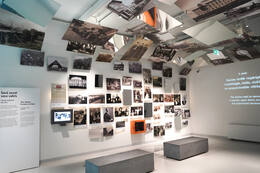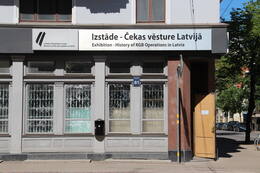Dissident during the USSR occupation
IV Soviet Occupation
A dissident (Latin: dissidens - apostate, speaking against) in the broadest sense is a person who holds different, opposing views than those of the existing authorities or the majority of society. Originally, this word meant people who did not belong to the dominant religion or denomination in the country.
In the 1960s, Western countries began to call dissidents oppositionists in the Soviet Union and other communist countries. This new opposition movement arose during the "thaw" period of the USSR leader N. Khrushchev. Dissidents differed from other opposition movements in that they used non-violent methods of struggle. Dissidents appealed to universal values, as well as rights that were written in Soviet laws, but were not respected. People were persecuted and repressed for dissidence, often imprisoned in psychiatric hospitals as "mentally ill". Notable Soviet dissidents were the writer Alexander Solzhenitsyn, the physicist Andrei Sakharov and others.
The most well-known Latvian dissidents during the occupation of Latvia were Gunārs Astra, Ints Cālītis, Eduards Berklavs, Lidija Doroņina-Lasmane, the so-called “French Group”, Knuts Skujenieks, Jurģis Skulme and others.
More information sources
Category: Dissidents. Wikipedia. https://lv.wikipedia.org/wiki/Kategorija:Dissidents
Eduards Berklavs. To know and not to forget. http://www.eraksti.lv/autori/eduards_berklavs.html
Biruta Eglīte. Who were you, Gunārs Astra? Riga, 1998.
Andris Grūtups. Observer. On the trial of the artist Jurģis Skulme. Riga, 2009.
Knuts Skujenieks, Bruno Javoišs. Cards. A virtual journey through barbed wire. Riga, 2013.
Vilis Seleckis. Dissident. The life story of Intas Cālītis. Riga, 2020.
Related objects
Museum of the Occupation of Latvia
The museum exhibits the history of Latvia from 1940 to 1991, under the occupation of Nazi Germany and the Soviet Union. ‘House of the Future’ is a reconstruction and expansion project of the Occupation Museum designed by the well-known American Latvian architect Gunārs Birkerts as well as the new exhibit of the museum. The exhibit ‘History of Cheka in Latvia’ was created by the Occupation Museum and it is located in the ‘Corner House’, which is the former USSR State Security Committee (KGB) building. Latvian Occupation Museum was founded in 1993. It tells the long-hidden story of the fate of the Latvian state, nation and land under the occupation of two foreign totalitarian powers from 1940 to 1991. At the end of 2020 the museum had more than 70,000 different historical items (documents, photographs, written, oral and material evidence, objects and memorabilia). Museum specialists have recorded more than 2,400 video testimonials, making it one of the largest collections on occupation in Europe. The events that unfolded in Latvia, Lithuania and Estonia clearly show us what the nations had to endure under the two totalitarian regimes.
Exhibition in the KGB Building "History of KGB Operations in Latvia"
The former USSR State Security Committee (commonly known as Cheka) building is open for visitors. Here chekists imprisoned, interrogated and murdered Latvian citizens who were considered opponents by the occupation regime. There is also an exhibit from the Latvian Occupation Museum on the activities of Cheka in Latvia. Guided tours of the prison cells, corridors, basement and courtyard are available. The house was built in 1911 and it is one of the most beautiful buildings in Riga. Called the ‘Corner House’ by the people, it was the scariest symbol of the Soviet occupation regime in Latvia, and also one of the pillars of power of the USSR. Cheka operated from the Corner House during the occupation from 1940 to 1941 and then again from 1945 to 1991. Tens of thousands of Latvians were affected by direct political persecution. The fight against enemies of Soviet rule continued also after World War II. Cheka’s approach towards its operation slightly changed after Stalin’s death. Physical torture was replaced by psychological terror. The majority of Cheka agents were Latvians (52%). Russians were the second largest group – 23.7%. 60.3% of the agents were not members of the Communist Party. 26.9% of the agents had higher education. The system was designed in a way to involve local people and thus have greater control over the society. Staff documents and service records are located in Russia. And these materials have not been made available to Latvian authorities and researchers.
Exhibition in the KGB Building "History of KGB Operations in Latvia"
The former USSR State Security Committee (commonly known as Cheka) building is open for visitors. Here chekists imprisoned, interrogated and murdered Latvian citizens who were considered opponents by the occupation regime. There is also an exhibit from the Latvian Occupation Museum on the activities of Cheka in Latvia. Guided tours of the prison cells, corridors, basement and courtyard are available. The house was built in 1911 and it is one of the most beautiful buildings in Riga. Called the ‘Corner House’ by the people, it was the scariest symbol of the Soviet occupation regime in Latvia, and also one of the pillars of power of the USSR. Cheka operated from the Corner House during the occupation from 1940 to 1941 and then again from 1945 to 1991. Tens of thousands of Latvians were affected by direct political persecution. The fight against enemies of Soviet rule continued also after World War II. Cheka’s approach towards its operation slightly changed after Stalin’s death. Physical torture was replaced by psychological terror. The majority of Cheka agents were Latvians (52%). Russians were the second largest group – 23.7%. 60.3% of the agents were not members of the Communist Party. 26.9% of the agents had higher education. The system was designed in a way to involve local people and thus have greater control over the society. Staff documents and service records are located in Russia. And these materials have not been made available to Latvian authorities and researchers.
Related stories
About General Karlis Goppers
General K. Goppers (1876-1941) was an outstanding soldier and an outstanding person. He distinguished himself as a successful commander who took command of battalions and regiments, heroically leading his riflemen in battles for the freedom of Latvia during the First World War (1914-1919). He participated in the battles at Tīreļpurva, Ložmetējkalns, and in the defense of Riga.
Regional researcher Žanis Skudra receives 10 years in prison for "Diary of Occupied Latvia"
Žanis Skudra devotes all his free time to local history, all his vacations to traveling around Latvia. This is how he accumulated materials, took photographs, and created the "Book of Occupied Latvia Days", which is published by the Latvian National Foundation in Stockholm under the pseudonym Jānis Dzintars.
On June 7, 1978, Žani Skudra was arrested in Tallinn and in November of the same year, the Riga Supreme Court sentenced him to twelve years in prison for treason and espionage.






